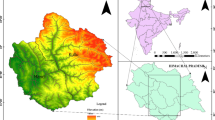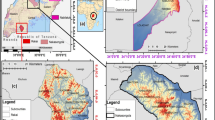Abstract
This study aims to trace changes in the dry spells over Peninsular Malaysia based on the daily rainfall data from 36 selected rainfall stations which include four subregions, namely northwest, west, southwest, and east for the periods of 1975 to 2004. Six dry spell indices comprising of the main characteristics of dry spells, the persistency of dry events, and the frequency of the short and long duration of dry spells will be used to identify whether or not these indices have increased or decreased over Peninsular Malaysia during the monsoon seasons. The findings of this study indicate that the northwestern areas of the Peninsular could be considered as the driest area since almost all the indices of dry spells over these areas are higher than in the other regions during the northeast (NE) monsoon. Based on the individual and the field significant trends, the results of the Mann–Kendall test indicate that as the total number of dry days, the maximum duration, the mean, and the persistency of dry days are decreased, the trend of the frequency of long dry spells of at least 4 days is also found to decrease in almost all the stations over the Peninsula; however, an increasing trend is observed in the frequency of short spells in these stations during the NE monsoon season. On the other hand, during the southwest monsoon, a positive trend is observed in the characteristics of dry spells including the persistency of two dry days in many stations over the Peninsula. The frequency of longer dry periods exhibits a decreasing trend in most stations over the western areas during both monsoon seasons for the periods of 1975 to 2004.





Similar content being viewed by others
References
Anagnostopoulou CHR, Maheras P, Karacostas T, Vafiadis M (2003) Spatial and temporal analysis of dry spells in Greece. Theor Appl Climatol 74(1–2):77–91
Brunetti M, Maugeri M, Monti F, Nanni T (2004) Changes in daily precipitation frequency and distribution in Italy over the last 120 years. J Geophys Res 109:D05102. doi:10.1029/2003JD004296
Burgueno A, Martinez MD, Lana X, Serra C (2005) Statistical distribution of the daily rainfall regime in Catalonia (NE) Spain for the years 1950–2000. Int J Climatol 25(10):1381–1403
Camerlengo AL (1999) Monthly frequency distributions of both dry spells and the number of days with precipitation greater than 25 mm over Peninsular Malaysia. Geoacta 23:1–18
Cheang BK, Tan HV, Yong PW (1986) Some aspects of wet and dry spells in Malaysia, 1951–1983. Part I: seasonal and monthly variations of wet and dry spells. Malaysian Meteorological Service, Research Publication No. 15. Malaysian Meteorological Service, Petaling Jaya
Cislaghi M, De Michele C, Ghezzi A, Rosso R (2005) Statistical assessment of trends and oscillations in rainfall dynamics: analysis of long daily Italian series. Atmos Res 77(1–4):188–202
Dai A, Trenberth KE, Karl TR (1998) Global variations in drought and wet spells: 1900–1995. Geophys Res Lett 25:3367–3370
Dale WL (1960) The rainfall of Malaya, part II. J Trop Geog 14:11–28
Deni SM, Jemain AA (2008) Probability models for dry spells in Peninsular Malaysia. Asia-Pacific J Atmos Sci 44:37–47
Deni SM, Jemain AA (2009) Mixed log series geometric distribution for sequences of dry days. Atmos Res 92(2):236–243
Deni SM, Jemain AA, Ibrahim K (2008a) The spatial distribution of wet and dry spells over Peninsular Malaysia. Theor Appl Climatol 94:163–173
Deni SM, Jemain AA, Ibrahim K (2008b) Fitting optimum order of Markov chain models for daily rainfall occurrences in Peninsular Malaysia. Theor Appl Climatol doi:10.1007/s00704-008-0051-3
Deni SM, Suhaila J, Wan Zin WZ, Jemain AA (2008c) Tracing trends in the sequences of dry and wet days over Peninsular Malaysia. J Environ Sci Tech 1:97–110
Deni SM, Suhaila J, Wan Zin WZ, Jemain AA (2009) Trends of wet spells over Peninsular Malaysia during monsoon seasons. Sains Malaysiana 38(2):133–142
Douglas EM, Vogel RM, Kroll CN (2000) Trends in floods and low flows in the United States: impact of spatial correlation. J Hydrol 240:90–105
Easterling DR, Evans JL, Groisman P, Karl TR, Krunkel KE, Amberje P (2000) Observed variability and trends in extreme climate events. Bull Am Meteorol Soc 81:417–425
Gong DY, Shi PJ, Wang JA (2004) Daily precipitation changes in the semi-arid region over northern China. J Arid Environ 59:771–784
Gong DY, Wang JA, Han H (2005) Trends of summer dry spells in China during the late twentieth century. Meteorol Atmos Phys 88:203–214
Groisman PY, Knight RW, Easterling DR, Karl TR, Hegerl GC, Razuvaev VN (2005) Trends in intense precipitation in the climate record. J Clim 18:1343–1367
IPCC (2001) Climate change, 2001. The scientific basis. In: Houghton JT et al (eds) Contribution of working group I to the third assessment report of the Intergovernmental Panel on Climate Change. Cambridge University Press, Cambridge 881 pp
IPCC (2007) Climate change, 2007. The physical science basis. In: Solomon S et al (eds) Contribution of working group I to the fourth assessment report of the Intergovernmental Panel on Climate Change. Cambridge University Press, Cambridge
Juneng L, Tangang FT, Reason CJC (2007) Numerical case study of an extreme rainfall event during 9–11 December 2004 over the east coast of Peninsular Malaysia. Meteorol Atmos Phys 98:81–98
Kampata JM, Parida BP, Moalafhi DB (2008) Trend analysis of rainfall in the headstreams of the Zamezi River Basin in Zambia. Phys Chem Earth 33:621–625
Karl TR, Knight RW (1998) Secular trends of precipitation amount, frequency, and intensity in the United States. Bull Am Meteorol Soc 79:231–241
Kendall MG (1975) Rank correlation methods, 4th edn. Griffin, London
Kulkarni A, Von Storch H (1995) Monte-Carlo experiments on the effect of serial correlation on the Mann–Kendall test of trend. Meteorol Z 4(2):82–85
Lana X, Serra C, Burgueno A (2003) Trend affecting pluviometric indices at the Fabra Observatory (Barcelona, NE Spain) from 1917 to 1999. Int J Climatol 23(3):315–332
Lettenmaier DP, Wood EF, Wallis JR (1994) Hydro-climatological trends in the continental United States, 1948–88. J Clim 7:586–607
Lim JT (1976) Rainfall minimum in Peninsular Malaysia during the Northeast monsoon. Mon Weather Rev 104:96–99
Livezey RE, Chen WY (1983) Statistical field significance and its determination by Monte Carlo techniques. Mon Weather Rev 111:46–59
Manton MJ, Della-Marta PM, Haylock MR, Hennessy KJ, Nicholls N, Chambers LE, Collins DA, Daw G, Finet A, Gunawan D, Inape K, Isobe H, Kestin TS, Lefale P, Leyu CH, Lwin T, Maitrepierre L, Ouprasitwong N, Page CM, Pahalad J, Plummer N, Salinger MJ, Suppliah R, Tran VL, Trewin B, Tibig I, Yee D (2001) Trends in extreme daily rainfall and temperature in Southeast Asia and the south Pacific: 1961–1998. Int J Climatol 21(3):269–284
New M, Todd M, Hulme M, Jones P (2001) Precipitation measurements and trends in the twentieth century. Int J Climatol 21:1899–1922
Partal T, Kahya E (2006) Trend analysis in Turkish precipitation data. Hydrol Process 20:2011–2026
Schmidli J, Frei C (2005) Trends of heavy precipitation and wet and dry spells in Switzerland during the 20th century. Int J Climatol 25:753–771
Seleshi Y, Camberlin P (2006) Recent changes in dry spell and extreme rainfall events in Ethiopia. Theor Appl Climatol 83(1–4):181–191
Serra C, Burgueno A, Martinez MD, Lana X (2006) Trends in dry spells across Catalonis (NE Spain) during the second half of the 20th century. Theor Appl Climatol 85(3–4):165–183
Su BD, Jiang T, Jin WB (2006) Recent trends in observed temperature and precipitation extremes in the Yangtze River basin, China. Theor Appl Climatol 83(1–4):139–151
Suhaila J, Deni SM, Jemain AA (2008a) Revised spatial weighting methods for estimation of missing rainfall data. Asia-Pacific J Atmos Sci 44(2):93–104
Suhaila J, Deni SM, Jemain AA (2008b) Detecting inhomogeneity of rainfall series in Peninsular Malaysia. Asia-Pacific J Atmos Sci 44(4):369–380
Sullivan DO, Unwin DJ (2003) Geographic information analysis. Wiley, Hoboken, NJ
Tangang FT, Juneng L, Salimun E, Vinayachandran PN, Yap KS, Reason CJC, Behera SK, Yasunari T (2008) On the roles of the northeast cold surge, the Borneo vortex, the Madden–Julian Oscillation, and the Indian Ocean Dipole during the extreme 2006/2007 flood in southern Peninsular Malaysia. Geophys Res Let doi:10.1029/2008GL033429
Teegavarapu RSV, Chandramouli V (2005) Improved weighting methods, deterministic and stochastic data-driven models for estimation of missing precipitation records. J Hydrol 312(1–4):191–206
Tolika K, Maheras P (2005) Spatial and temporal characteristics of wet spells in Greece. Theor Appl Climatol 81:71–85
Vicente-Serrano SM, Cuadrat-Prats JM (2007) Trends in drought intensity and variability in the middle Ebro vally (NE of the Iberian peninsula) during the second half of the twentieth century. Theor Appl Climatol 88:247–258
Von Storch H, Navarra A (1995) Analysis of climate variability—applications of statistical techniques. Springer, New York
Wijngaard JB, Klien Tank AMG, Konnen GP (2003) Homogeneity of 20th century European daily temperature and precipitation series. Int J Climatol 23:679–692
Wu H, Hayes MJ, Wilhite DA, Svoboda MD (2005) The effect of the length of record on the standardized precipitation index calculation. Int J Climatol 25:505–520
Ye Z, Hseih WW (2006) The influence of climate regime shift on ENSO. Clim Dyn 26:823–833
Yue S, Hashino M (2003) Long term trends of annual and monthly precipitation in Japan. J Am Water Resour Assoc 39:587–596
Yue S, Pilon P (2003) Canadian streamflow trend detection: impacts of serial and cross correlation. Hydrol Sci J 48(1):51–63
Yue S, Pilon P, Phinney B, Cavadias G (2002) The influence of autocorrelation on the ability to detect trend in hydrological series. Hydrol Process 16:1807–1829
Acknowledgment
The authors are indebted to the staff of the Drainage and Irrigation Department and Malaysian Meteorological Department for providing the daily rainfall data for this study. This research would not have been possible without the sponsorship from Universiti Teknologi MARA (UiTM), Universiti Kebangsaan Malaysia (UKM), and Universiti Teknologi Malaysia (UTM). They also acknowledge their sincere appreciation to Prof. Dr. Hartmut Grassl and both reviewers for their valuable suggestions and remarks which improved the manuscript. This research was funded by Universiti Kebangsaan Malaysia (UKM-GUP-PI-08-34-318).
Author information
Authors and Affiliations
Corresponding author
Rights and permissions
About this article
Cite this article
Deni, S.M., Suhaila, J., Wan Zin, W.Z. et al. Spatial trends of dry spells over Peninsular Malaysia during monsoon seasons. Theor Appl Climatol 99, 357–371 (2010). https://doi.org/10.1007/s00704-009-0147-4
Received:
Accepted:
Published:
Issue Date:
DOI: https://doi.org/10.1007/s00704-009-0147-4




